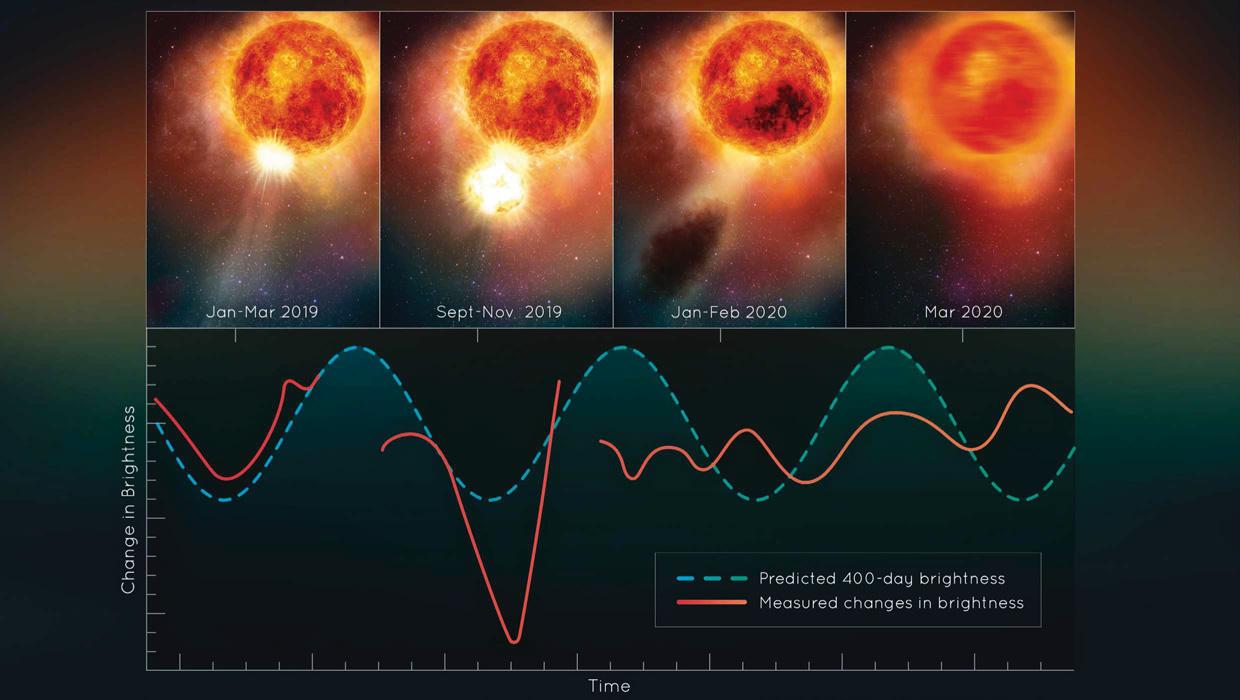
Three years ago, amateur astronomers around the world watched as the usually bright light of Betelgeuse dimmed overnight and remained that way for several months. Now a group of astronomers have determined it was caused by a piece of the star's atmosphere being ejected into space.
"We've never before seen a huge mass ejection of the surface of a star," says Andrea Dupree from the Center for Astrophysics, Harvard and Smithsonian, who led the study.
Betelgeuse is a red giant star over 1.6 billion kilometres wide - meaning if it replaced our Sun it would swamp Jupiter and almost reach Saturn. It has ballooned in size as it is approaching the end of its life and will eventually go supernova.
Though this is unlikely to happen for the next 10,000 years, it gives astronomers a unique view of a star in its final centuries. Over 200 years of observations have shown that the star's brightness slowly pulses according to a 400-day cycle, but the scale and speed of the 2019 dimming was unprecedented.
Drawing together observations from all over the world, Dupree has determined that material bubbling up within the star blasted off a piece of the photosphere. The ejection had a mass several times that of our Moon - a colossal 400 billion times more than what our Sun typically gives off during coronal mass ejections. As this fractured piece cooled, it formed a dust cloud that blocked Betelgeuse's light from Earth, causing it to appear dimmer.
It also appears that Betelgeuse's 400-day brightness cycle has stopped, or at least paused. Spectral Hubble observations taken by Dupree showed signs that this event and the star's attempts to rebuild its photosphere have disrupted the internal motions that drive the cycle.
この記事は BBC Sky at Night Magazine の October 2022 版に掲載されています。
7 日間の Magzter GOLD 無料トライアルを開始して、何千もの厳選されたプレミアム ストーリー、9,000 以上の雑誌や新聞にアクセスしてください。
すでに購読者です ? サインイン
この記事は BBC Sky at Night Magazine の October 2022 版に掲載されています。
7 日間の Magzter GOLD 無料トライアルを開始して、何千もの厳選されたプレミアム ストーリー、9,000 以上の雑誌や新聞にアクセスしてください。
すでに購読者です? サインイン

Could We Find Aliens by Looking for Their Solar Panels?- Designed to reflect ultraviolet and infrared, the panels have a unique fingerprint
Researchers searching for life beyond Earth spend a lot of time thinking about what telltale signs might be detectable astronomically. Forms of unambiguous evidence for the presence of life on another world are known as biosignatures. By extension, techno signatures are indicators of activity by intelligent, civilisation-building life.

Antimatter- In our continuing series, Govert Schilling looks at antimatter, the strange counterpart to most of the matter filling our Universe
Particles and corresponding antiparticles are very much alike, except they have opposite electrical charges. For instance, the antiparticle of the electron - known as the positron - has the same tiny mass, but while electrons carry a negative electrical charge, positrons are positively charged.

Where Have All The Milky Way's Early Stars Gone?- Our Galaxy has a curious lack of pristine stars
The Big Bang produced a Universe filled almost exclusively with hydrogen and helium; all other elements - what astronomers call metals - were produced by stars, supernovae and everything that happens later. So if you can pick out a pristine star with no metals polluting it from among the billions in the Milky Way, then you are likely to have a star dating from our Galaxy's earliest days.

Inside The Sky At Night - Two years ago, exoplanet scientist Hannah Wakeford received some of the first data from the JWST
Two years ago, exoplanet scientist Hannah Wakeford received some of the first data from the JWST. In July's Sky at Night, we discovered what she's learned since then.

How to stack DSLR data in Siril
Easily combine multiple frames to boost detailin your astro photos

Lunar occultation of Saturn
You'll need to strike a balance on 21 August to capture the Moon covering the ringed planet

How to plot a variable star light curve
A rewarding project to chart stars that change brightness

Smartphone photography with a telescope
Mary Mcintyre explains how to get impressive night-sky images using your phone

Once-a-century solar storm is overdue
If a Carrington Event struck today it would be catastrophic, says Minna Palmroth

The new era of human spaceflight
There's been a step-change in crewed space missions since the dawn of the 21st century. Ben Evans charts its course and looks ahead to future horizons